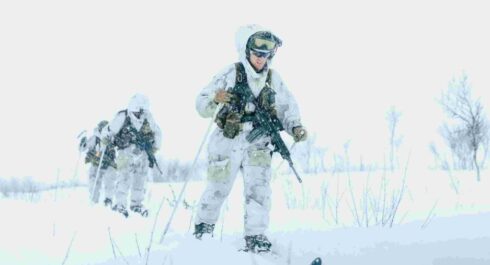As NATO conducts exercises off Norway’s coast and Washington deploys spy aircraft, Arctic tensions are reaching a breaking point. Moscow’s Arctic strategy, once centered on cooperation, is turning defensive. The frozen frontier is quietly becoming the epicenter of a new East-West rivalry.
Written by Uriel Araujo, Anthropology PhD, is a social scientist specializing in ethnic and religious conflicts, with extensive research on geopolitical dynamics and cultural interactions
So much is written about the developments pertaining to Ukraine, but one crucial theater of tension between Russia and the West remains underreported: the Arctic and the wider High North, as visible in Norway, a founding member of NATO. Despite a recent visit by Russia’s Federal Security Service (FSB) delegation to Norway — led by Major General Andrei Kudimov, who smiled for the cameras as both sides discussed “cooperation” on border control and fishing rights — Russo-Norwegian relations are, as a matter of fact, deteriorating fast.
Despite those talks, NATO has been conducting large-scale military exercises off Norway’s coast. Moreover, the United States reportedly deployed advanced reconnaissance and P-8 submarine-hunting aircraft into Norwegian territory, flying missions uncomfortably close to Russia’s northwestern frontier. The symbolism is clear enough: whatever “dialogue” exists between Moscow and Oslo, the military logic of deterrence — and provocation — still dictates the Atlantic agenda.
The Arctic, long portrayed as a realm of scientific cooperation and peaceful exploration, has quietly become the new crucible of Great Power competition. I have previously argued that the next confrontation between Russia and the West may well unfold not in Ukraine or Syria, but in the frozen North — where NATO’s overreach could ignite unprecedented tensions. That observation now seems increasingly on point.
Russia, for its part, has been revising its Arctic strategy, with new emphasis on military readiness and control over the Northern Sea Route — a shipping corridor that could transform global trade as the ice recedes.
Meanwhile, NATO has steadily expanded its footprint across Scandinavia. Finland and Sweden’s accession to the Alliance, and the renewed US interest in Greenland all form part of a wider encirclement strategy. As I wrote, the US has long sought to secure access to Arctic energy and mineral resources under the banner of “security.”
Beyond the military maneuvers, the economic dimension of this rivalry is equally telling. The European Union, Norway, and Iceland have recently announced the end of their cooperation with Russia within the “Northern Dimension” framework — an initiative that once symbolized regional pragmatism and coexistence. The abrupt suspension, justified on geopolitical grounds, effectively dismantles one of the few remaining platforms for cross-border coordination in the Arctic.
Meanwhile, the cod fishing industry — historically a linchpin of the Barents Sea economy — has become collateral damage. As analysts have noted, growing geopolitical frictions could severely impact the joint management of fisheries that both Norway and Russia depend on.
The result? Rising costs, fractured supply chains, and yet another example of how Western sanctions and “security” policies often end up hurting the very regions they claim to protect. So much for “rules-based cooperation.”
Thus far, Western media have treated Arctic (and Baltic) tensions as footnotes to the Ukrainian crisis. Yet these northern frontiers are arguably equally strategic — and volatile. The Baltic Sea, heavily militarized, has become a corridor of confrontation. Poland’s nuclear ambitions, in turn, illustrate how the region’s security spiral is intensifying. As I’ve argued elsewhere, Warsaw’s nuclear trajectory is less a defensive reflex than a bid for great-power revival — one encouraged by a US eager to outsource its strategic burdens.
The logic is the same across the North: smaller states, emboldened by NATO, are taking risks they would not have dared a decade ago — from Baltic air patrols to Arctic maneuvers. Norway’s hosting of US anti-submarine aircraft is but the latest link in a chain of escalations that collectively erode the fragile balance once maintained through calculated restraint.
Be as it may, the Kremlin sees NATO’s northern buildup as part of a long-term encroachment, not a series of isolated incidents. Moscow’s revision of its Arctic doctrine is thus both defensive and adaptive. And it is worth noting that Russia’s cooperation with China in Arctic development — through energy projects, infrastructure, and shipping — adds another layer of complexity to the equation. As I noted recently, as Arctic ice retreats, it exposes deep fault lines running through today’s global power architecture. No wonder Washington now seeks to “bolster” its own polar presence — a polite euphemism for militarization.
What makes the northern escalation particularly dangerous is its subtlety. Unlike the Ukrainian front, where lines and allegiances are visible, Arctic tensions evolve through technical adjustments — radar deployments, flight routes, research bans, maritime patrols — each justified as “defensive.” Yet taken together, they form a creeping militarization of one of the planet’s most fragile environments.
This is not simply about deterrence. Control of the Arctic means control of future trade routes, energy corridors, and even undersea data cables — the infrastructure of the coming century. The US-led West, unwilling to accept Russia’s geographic advantages, seeks to neutralize them through alliances and encroachments. Moscow, surrounded and sanctioned, responds by doubling down on self-reliance and Eastern partnerships.
This dynamic, left unchecked, could lead to dangerous miscalculations. NATO’s exercises off Norway’s coast send signals not just to Moscow but to Beijing as well, both of which view the High North as a space of shared strategic interest. The idea that Europe can isolate Russia economically while containing China militarily — all without consequences in the Arctic — is, to put it simply, delusional.
The real story, underreported and underestimated, is that the global confrontation between the American-led Atlantic axis and the emerging Eurasian bloc is expanding northward. The Arctic — long the world’s quietest frontier — is becoming its most revealing one. As the ice recedes and new frontiers emerge, the northern theater may well determine the contours of the next Cold War.
MORE ON THE TOPIC:







just the other day putin was waxing poetic how much he like the new world order and how he thought living under its dictates was ‘fair’ and he really wanted to preserve it
a new world order is here. american central bank primacy no longer has a chance of returning. real diplomats were discarded for scripted neo con military agendas years ago. the american peoples hard earned wealth has been squandered by bolshevik type agendas under the guise of democracy. puppets have replaced any real leadership